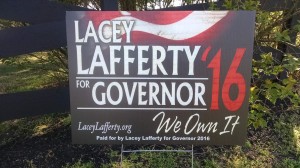I do not live in the First State of Delaware, but I work there as does my wife. So despite the fact I have no vote in the process, to me tomorrow’s primary is important enough to devote a post to. As originally intended, I had a pair of questions to ask of each of the four gubernatorial candidates regarding development and job creation that I sought their answer to so I e-mailed them to each candidate and listed it as a press inquiry. For the record, I only received a response from the campaign of Republican Colin Bonini asking for my phone number to do an interview. But I decided that wouldn’t be right to be that one-sided, nor am I a great fan of not having answers in writing. So this piece became more of a general overview.
In a political sense, Delaware is a lot like Maryland: dominated by Democrats who live in one heavily-populated area of the state, while the downstate area is more Republican and conservative. To buttress that point, Democratic gubernatorial candidate (and current Congressman) John Carney was born and lives in the Wilmington area while the two Republicans facing off to oppose him, State Senator Colin Bonini and businesswoman Lacey Lafferty, live in Kent and Sussex counties, respectively.
And in John Carney you also have a Ivy League liberal who’s been in government for most of his adult life as an appointee who moved up to Lieutenant Governor for two terms but was defeated in his effort to succeed his “boss” (in a manner of speaking, since the positions are elected separately in Delaware) in the 2008 Democratic primary by current Governor Jack Markell. Undaunted, John just waited until the opening came in 2010 to run for Congress since then-Rep. Mike Castle opted to run for the Senate seat that opened up when Joe Biden became Vice President. (The seat had a placeholder appointee until the 2010 election, which was to finish the last four years of Biden’s term. This was the primary Castle lost to Christine O’Donnell.) John Carney won the Delaware Congressional seat Castle was vacating and probably would have been happy to stay in Congress except that Joe Biden’s son Beau, who was the odds-on favorite to run for and win Delaware’s highest office in 2016, passed away from cancer last year. So Carney seems to be the recipient of the “Delaware Way” of particular officeholders cycling between political jobs.
One thing I noticed in taking a cursory read of Carney’s campaign site: he uses the word “invest” a lot. Those in the know realize this means a LOT more government spending and that, to me, is bad for business. Higher taxes aren’t the way to attract the clientele that keeps my employer going, either.
But the winner of the GOP primary faces the long odds of trying to overcome Carney, who has name recognition aplenty and will certainly be burning up our local airwaves in the next couple months since Salisbury (and Rehoboth Beach, where the local NBC affiliate’s broadcast orignates) is actually the TV market serving southern Delaware.
It’s a contest between a man who has been in political office since 1994 (and was elected at the age of 24, meaning he has spent nearly half his life in office) and a woman who apparently began her run almost as soon as the votes were counted from the 2012 gubernatorial election.
 There are definitely some things to like about Colin Bonini: he has the good idea to make Delaware a right-to-work state and would encourage the streamlining of state government by offering longtime employees an early retirement package. Legislatively, he has ranked as the most conservative legislator in the Senate (although out of 21 that may not be the greatest achievement.) However, he has the luxury of running from cover as his legislative seat isn’t up for election this time and, quite frankly, this may not be the year for entrenched politicians on the Republican side.
There are definitely some things to like about Colin Bonini: he has the good idea to make Delaware a right-to-work state and would encourage the streamlining of state government by offering longtime employees an early retirement package. Legislatively, he has ranked as the most conservative legislator in the Senate (although out of 21 that may not be the greatest achievement.) However, he has the luxury of running from cover as his legislative seat isn’t up for election this time and, quite frankly, this may not be the year for entrenched politicians on the Republican side.
At least that’s what Lacey Lafferty is hoping for. Now I have heard Lafferty on the radio a couple times (since I often listen to Delaware talk radio) and she seems to have the political style people associate with Donald Trump insofar as running as an outsider. (Like Trump, she was once a Democrat, too.) And the rhetoric isn’t far off, either:
Sen. Bonini is the choice of the establishment, but Ms. Lafferty believes she will win.
She’s been critical of her primary opponent, referring to him on Twitter as “lazy” and a “buffoon.” Sen. Bonini represents part of a failed political culture, Ms. Lafferty said, noting he did not officially unveil his campaign until recently.
“This is what people are sick of,” she said. “They’re tired of this. They want somebody that they can depend upon.”
Sen. Bonini has referred to her as a “fringe candidate,” and more recently, he stressed Republican voters should select the person with “the best chance to win in November.”
As of Aug. 14, he had about $66,000 on hand, while Ms. Lafferty had $4,400.
Delaware State University professor Sam Hoff foresees Ms. Lafferty pulling in about 15 percent of the primary vote, largely from more left-leaning Republicans.
Apparently there aren’t a lot of polls done in Delaware, but the poll I did find has the race at 29-22 Bonini. And since I have heard Lafferty identify with Trump on several occasions, I don’t think she would be t he choice of “left-leaning” Republicans.
he choice of “left-leaning” Republicans.
I have to give credit to Lafferty for working hard to build a grassroots campaign, with the best philosophical idea I noted from her being that of stressing vocational education. I agree that not all students are college material, but those who can work with their hands and aren’t afraid of a little effort can succeed quite well in life. She has quite the distinctive yard signs, too. (Don Murphy would hate them but you have to admit they are artistic.) And I see quite a few of them driving around Sussex County.
So Republican voters of Delaware have an interesting choice to make tomorrow for governor. They can pick the candidate who has lots of experience in lawmaking and owns a very conservative voting record; someone who is likely perceived as the safe choice but may not have the appeal for people to cross party lines.
Or they can select someone who is, to be honest, more of a wild card. We have no idea whether she will be polished on the stump or self-destruct when the people begin to pay attention. It’s possible she was a tough-talking conservative the entire campaign but finds out there’s not the waste, fraud, and abuse she thinks there is in state government – not to mention has to deal with Bonini as a state senator who would have to push her agenda.
I would be remiss if I didn’t note there will be other candidates on the November gubernatorial ballot, including Libertarian Sean Goward – who may be hoping for a boost from the national ticket with Gary Johnson polling in the high single digits. Goward hasn’t been one to update his website much, though.
On the other hand, the contest for Lieutenant Governor is solely on the Democratic side, as La Mar Gunn is the only GOP stalwart to run. (He’s best known for “losing” the Kent County Recorder of Deeds race in 2014 by two votes – the first recount that the Democratic incumbent Betty McKenna won after Gunn won on Election Day by two votes and won two recounts by similar – but not those exact – margins.) Between the six candidates on the Democratic ballot (Sherry Dorsey Walker, Brad Eaby, Greg Fuller, Bethany Hall-Long, Kathy McGuiness, and Ciro Poppiti) you find varying levels of political experience but more or less the same amount of liberalism – basically peas in a pod.
There’s also a Congressional race with one Republican (Hans Reigle), one Libertarian (Scott Gesty), and (again) six Democrats – Sean Barney, Mike Miller, Lisa Blunt Rochester, Bryan Townsend, Scott Walker, and Elias Weir. In looking through their positions, this November you can decide between Reigle, who seems to me a right-of-center sort who would probably fall midway between the most conservative and liberal Republicans in Congress, the fairly classic small-government, non-interventionist Libertarian Gesty, and the Democrat who will be way left of center whoever he or she is. Again, peas in a pod.
I’m not involved with the Delaware Republican Party, but it seems to me they have a harder time getting candidates than even our loony-bin left state of Maryland does. In one respect this prevents bitter primary fights, but there’s also the aspect of leaving rank-and-file voters out of the decision. Between the statewide races this year (governor, lieutenant governor, insurance commissioner, and Congressman) the Republicans only have six candidates on the ballot. Democrats match that in either of two prominent races. Note that the voter registration numbers are less dire in the First State compared to Maryland – in Delaware only 48% are Democrats, 28% Republican, and 24% “others.” (There are more Democrats in New Castle County, however, than Republicans or “others” in the entire state.)
Unlike Maryland politics, I look at the situation in Delaware as an interested observer rather than an erstwhile participant because, as I said up top, I work in the state. But as one who lives across the Transpeninsular Line I think I speak for the people of Delaware who want their state to succeed. Above all, I want it to be attractive to new residents and prosperous for those already there because that helps to make my paycheck, so vote wisely in the primary.

